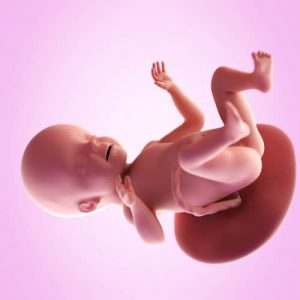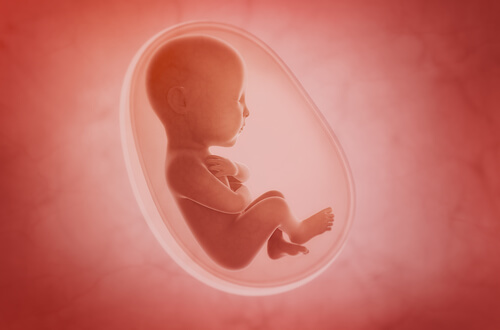The 26th Week of Pregnancy
3 minutes

Last update: 30 April, 2018
By the 26th week of pregnancy, the woman has already adapted to changes in her body as her baby grows. 75% of the gestation period has already elapsed.
The mother should know that changes are accelerated in the final stretch because the baby is preparing for birth.
The 26th week of pregnancy
- The increase in weight is proportionally more accentuated as the fetus is experiencing faster growth than in the previous weeks.
- As a result of this growth, the uterus expands. This, in addition to the baby’s freer and more frequent movements, will cause some discomfort.
- The mother will need to change her position frequently, especially when she’s lying down and resting. She’ll try to move her “belly” in order to be more comfortable.
- One suggestion is to use a pillow or cushion between the legs or under the belly to reduce discomfort.
- The uterus will press more on the bladder, so the mother will feel like urinating very often. The bladder’s holding capacity is reduced.
- The woman will notice that her belly moves a lot and she’ll surely say her child “kicks.”
- At certain times, irregular shapes will appear in the belly, which responds to the baby’s movements and changes of position.
- A certain amount of anemia is frequently detected at this stage of pregnancy.
- Anemia manifests as fatigue and lethargy. The sclera, the white part of the eye, turns yellowish and the woman looks pale.
- Generally, the doctor orders blood and urine tests to detect nutrient deficiencies. Sometimes the doctor will suggest that the mother take iron supplements.
- Now is the time to control sugar levels, because gestational diabetes can appear this week.

- Hormonal changes will surely affect the mother’s mood. She’ll easily go from laughter to tears with no apparent cause.
- Sexuality will resurface. Her sex drive will be stronger.
- On the one hand, this occurs because the woman feels calmer now that the pregnancy has advanced. She has become accustomed to her new body and accepts it as natural.
- On the other hand, hormones affect the body with greater intensity and contribute to this increase in desire. It’s time to enjoy sexuality without fear, unless there is a medical contraindication.
The baby at the 26th week of pregnancy
- At this stage of its development, the baby will begin to manifest signs of a more autonomous life.
- He’ll move more freely. He still has enough space in the uterus to move and “exercise” different parts of his body.
- As the baby grows, the amniotic fluid reduces, so his movements are more noticeable from the outside.
- He reacts to external stimuli. Light and sounds reach him. He also feels as if there is some kind of pressure on the belly.

- It’s time for mom and dad to talk to him and share music with him. These stimuli will prepare him for his life after birth.
- His weight is between 800 g and 1 kg, and he measures about 35 cm from head to toe. From this moment until birth, his weight will triple.
- The face is refined and begins to acquire the shape it will have at birth. The ultrasound will clearly show the eyebrows, as well as the nails on the hands and feet.
- It’s usually in the 26th week of pregnancy when the baby is placed in the so-called fetal position. His neck, arms and legs will flex in toward his chest and abdomen.
- He’ll begin to practice his breathing movements. He is rehearsing the first puffs of air he’ll take when he is born.
Suggestions for the 26th week of pregnancy
- The 26th week of pregnancy is crucial for both the baby and the mother, so both must have rigorous health.
- It’s essential to maintain a relaxed lifestyle, without anxiety or stress.
- Moderate physical exercise, under the supervision of specialists, will help reduce discomfort. This will produce good psychological and physical effects.
All cited sources were thoroughly reviewed by our team to ensure their quality, reliability, currency, and validity. The bibliography of this article was considered reliable and of academic or scientific accuracy.
- Chelli, D., & Chanoufi, B. (2008). Audition foetale. Mythe ou réalité ? [Fetal audition. Myth or reality]. Journal de gynecologie, obstetrique et biologie de la reproduction, 37(6), 554–558. https://doi.org/10.1016/j.jgyn.2008.06.007
- Nasello-Paterson, C., Natale, R., & Connors, G. (1988). Ultrasonic evaluation of fetal body movements over twenty-four hours in the human fetus at twenty-four to twenty-eight weeks’ gestation. American journal of obstetrics and gynecology, 158(2), 312–316. https://doi.org/10.1016/0002-9378(88)90145-7
- MedlinePlus [Updated 2021 May 4]. Fetal development. Available from: https://medlineplus.gov/ency/article/002398.htm
- Suzuki, M., Saito, H., & Yanaihara, T. (1999). Assessment of fetal nasal fluid flow by two-dimensional color Doppler ultrasonography during pregnancy. The Journal of maternal-fetal medicine, 8(4), 159–163. https://doi.org/10.1002/(SICI)1520-6661(199907/08)8:4<159::AID-MFM4>3.0.CO;2-O
- Sleep Foundation [Updated 2020 October 30]. Pregnancy and Sleep. Available from: https://www.sleepfoundation.org/pregnancy
- Children’s Hospital of Philadelphia. Migraine Headaches During Pregnancy. Available from: https://www.chop.edu/conditions-diseases/migraine-headaches-during-pregnancy
- Mayo Clinic [Published 2020 Oct 7]. Embarazo semana a semana. Available from: https://www.mayoclinic.org/es-es/healthy-lifestyle/pregnancy-week-by-week/in-depth/pregnancy/art-20046098
- Koh, T. H., Harrison, H., & Casey, A. (2000). Prediction of survival for preterm births. Survival table was not easy to understand. BMJ (Clinical research ed.), 320(7235), 647.
This text is provided for informational purposes only and does not replace consultation with a professional. If in doubt, consult your specialist.
